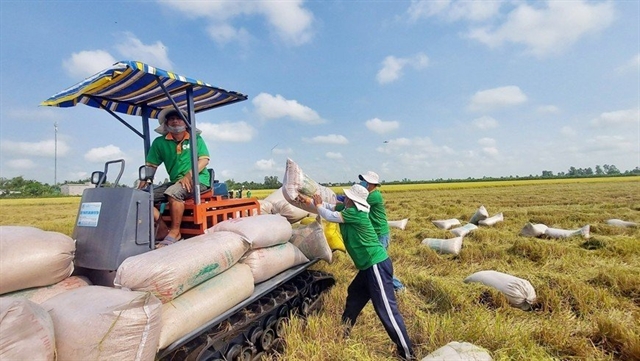 Economy
Economy

 |
| Việt Nam is expected to export about 7.5 million tonnes of rice in 2023. — Photo tapchicongthuong.vn |
HÀ NỘI — Việt Nam will seize the opportunity in the international marketplace to elevate rice exports at a premium price, while still preserving food security.
This announcement was made by the Minister of Industry and Trade, Nguyễn Hồng Diên, at a meeting concerning the management of rice exports for the remainder of the year, organised by the Ministry of Industry and Trade (MoIT) in Cần Thơ City on Friday.
Diên indicated that following India's imposition of a rice export ban approximately two weeks ago, the export cost of Việt Nam's 5 per cent broken rice rose from $535 to $602 per tonne; and the price of its Jasmine rice jumped from $625 to $690 per tonne as of August 4.
Given these circumstances, businesses must capitalise on the situation to bolster rice production and exports and to sell this staple at an elevated price. However, Việt Nam must also retain its rice brand integrity and safeguard national food security, he added.
Evaluating the domestic demand and production capability, the MoIT has asserted that Việt Nam has the capacity to export a minimum of 7.5 million tonnes of rice in 2023.
Trần Duy Đông, head of MoIT's Import-Export Department, quoted the Ministry of Agriculture and Rural Development (MARD)'s statistics as saying that Việt Nam's rice production in 2023 was expected to reach from 43.2 to 43.4 million tonnes, up 1.8-2 per cent compared to 2022. The rice output in the first seven months of 2023 reached over 24.1 million tonnes, up 0.4 per cent.
According to Đông, provinces are speeding up the production of Autumn-Winter and Spring rice crops with an expected increase of 50,000 hectares over the same period last year, reaching 700,000 hectares.
Deputy Minister of Agriculture and Rural Development Hoàng Trung said that if the total area growing rice is increased by 50,000 hectares of autumn-winter rice crops to promote rice exports, Việt Nam could earn more than $100 million. That would ensure food supply for the world and also increase income for farmers.
"Until the end of the year, if there are no abnormal changes in the weather, the rice production will meet the domestic rice consumption and exports," Đông said.
Việt Nam is expected to export about 7.5 million tonnes of rice in 2023.
The exports in the first seven months were estimated to reach about 4.83-4.84 million tonnes, according to Đông. Therefore, the exports in the last five months of the year are forecasted to reach about 2.66-2.67 million tonnes.
Besides, Việt Nam has also imported rice from Cambodia for processing export products.
Prof. Võ Tòng Xuân, a specialist in rice cultivation, said Việt Nam had a good opportunity to escalate its rice exports at augmented prices. To seize this chance, businesses were advised to secure future contracts for rice exportation in the coming year with predetermined pricing to ensure a fair price for rice exports.
Drawing parallels to future contracts seen with coffee and corn, these agreements would ensure predictable rice consumption down the line, Xuân explained.
To achieve this, businesses must collaborate with local governance to persuade farmers to adhere to stipulated production processes and quality standards, thus establishing supply chains for rice that can trace the origin of the rice products, he said.
Farmers were required to innovate by aligning with cooperatives and prioritising farming techniques that enhance the quality of the rice grain, Xuân said.
"Now, it's imperative that businesses, the state, and farmers unite their efforts to bolster the prestige and quality of Vietnamese rice," he said.
Trading rice
Meanwhile, Deputy Minister of Industry and Trade Đỗ Thắng Hải has sent a dispatch to the authorities of provinces and centrally-run cities to ask them to stabilise the rice market in the current situation.
In particular, the ministry has warned businesses to avoid buying rice in bulk, causing an imbalance of supply and demand and pushing up local rice prices.
Accordingly, the localities request the businesses participating in the market stabilisation programmes to ensure rice supply to the market with stable prices from now until the end of the year and the Lunar New Year in 2024.
At the same time, the rice export enterprises are asked to maintain a stable volume of paddy and rice in reserve, and carry out purchasing and delivery of rice exports according to a reasonable schedule based on a balance between the export volume and the supply for the domestic market.
Regarding trading rice export activities, the Vietnam Chamber of Trade and Industry (VCCI) has proposed to continue reducing investment and business conditions for rice export activities, moving towards market liberalisation, according to VCCI's opinions on the draft amending Decree 107/2018/NĐ-CP on trading export rice.
Businesses said that they must have entrustment in the rice export to qualified enterprises with a fee of about $1-5 per tonne of rice because they could not meet the existing rice export business conditions.
This presented challenges in the trade of export rice, particularly for small and medium-sized enterprises.
Such enterprises were calling for the local People's Committee or the Department of Industry and Trade to be the ones to issue trading certificates for rice exporting businesses. This move would alleviate the cost and time needed to secure these certificates.
The validity of the certificate spans five years, as specified by Decree 107. However, local Departments of Industry and Trade continue to conduct periodic checks on enterprises to ensure they satisfy business conditions, including the maintenance of warehouses and mills. They have the authority to revoke certificates immediately if these enterprises fail to meet the criteria.
As a result, businesses are suggesting that they should not be compelled to reapply for a new certificate every five years.
Furthermore, to comply with the technical regulation on warehouses and rice mills as dictated by Circular 12/2013/TT-BNNPTNT, businesses need substantial investment. These conditions pose a challenge for smaller businesses. —VNS




